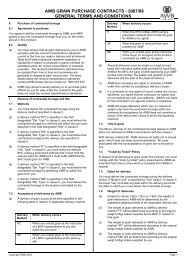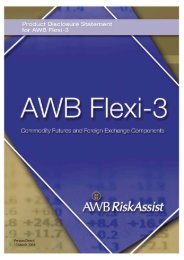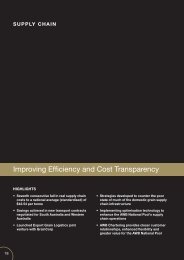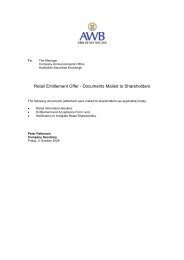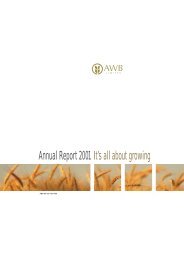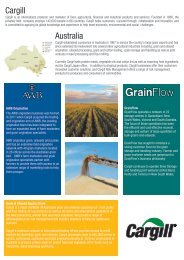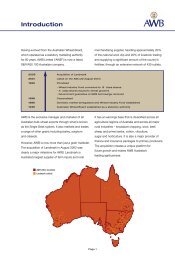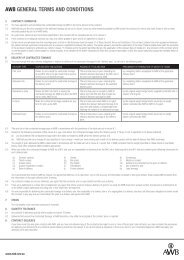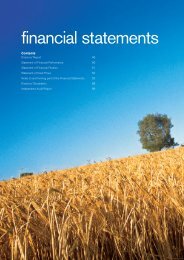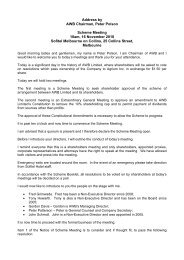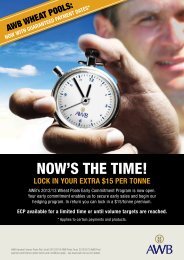Annual Report - AWB Limited
Annual Report - AWB Limited
Annual Report - AWB Limited
You also want an ePaper? Increase the reach of your titles
YUMPU automatically turns print PDFs into web optimized ePapers that Google loves.
Notes to and forming part of the financial statements for the year ended 30 September 2008 <strong>AWB</strong> LIMITEDOther taxesRevenues, expenses and assets are recognised net of the amount ofGST except:• when the GST incurred on a purchase of goods and services is notrecoverable from the taxation authority, in which case the GST isrecognised as part of the cost of acquisition of the asset or as partof the expense item as applicable; and• receivables and payables, which are stated with the amount of GSTincluded.The net amount of GST recoverable from, or payable to, the taxationauthority is included as part of receivables or payables in the balancesheet.(s) Derivative financial instrumentsThe Group uses derivative financial instruments to economically hedgeits risk associated with foreign currency, interest rate and commodityprice risk. Such derivative financial instruments are initially recognisedat fair value on the date on which a derivative contract is enteredinto and subsequently remeasured to fair value. Hedge accounting isnot applied and, as such these instruments are classified as held fortrading as required by AASB 139 Financial Instruments: Recognition andMeasurementThe fair value of forward exchange contracts is calculated byreference to current forward exchange rates for contracts withsimilar maturity profiles. The fair value of interest rate swapcontracts is determined by reference to market values for similarinstruments. The fair value of forward freight agreements, forwardpurchases and forward sales of inventory is determined by referenceto market values for similar instruments. The fair value of physicalfreight contracts is determined with an element of judgement byreference to quoted prices and adjustments are made based onactual route and vessel size.Derivatives outstanding at balance date are valued at the rates rulingon that date and any gains or losses are brought to account in theincome statement.Changes in the fair value of any derivatives instruments are recognisedimmediately in the income statement.(t) LeasesLeases where the lessor retains substantially all the risks and benefitsof ownership of the assets are classified as operating leases. Initialdirect costs incurred in negotiating an operating lease are added tothe carrying amount of the leased asset and recognised over the leaseterm on the same bases as the lease income.Operating lease payments are recognised as an expense in the incomestatement on a straight-line basis over the lease term.(u) Revenue recognition and other incomeRevenues are recognised and measured at fair value of theconsideration received or receivable to the extent it is probable thatthe economic benefits will flow to the Group and the revenue can bereliably measured.SalesRevenue from sales made on commercial terms is recognised whentitle for the commodity transfers to the customer. In the case of exportsales, the bill of lading (shipment) date is taken as the transaction dateunless title is to pass at a materially different time.Service and commission revenueService and commission revenue charged on a range of businessservices are a fee for the service of providing rural merchandise andfertiliser, agronomy services, livestock and wool marketing services,insurance, real estate marketing services and financial products.Service and commission revenue are recognised according to whenthe costs of providing the services are incurred.Interest revenueInterest revenue is recognised as it accrues using the effective interestrate method. The accrual of income is suspended on accounts whichare impaired.DividendsDividend revenue is recognised when the Group’s right to receive thepayment is established.Underwriting feeThe underwriting fee charged on loan products is a fee for theservice of providing a non-recourse loan. Underwriting fee revenue isrecognised on a basis consistent with the pattern of the incidence ofrisk covered by the service provided.Sale of non-current assetsThe gain or loss on the sale of non-current assets is included as otherincome at the date control of the asset passes to the buyer, usuallywhen an unconditional contract of sale is signed. The gain or loss ondisposal is calculated as the difference between the carrying amountof the asset at the time of disposal and the net proceeds on disposal.Rental incomeRental income from sub-lease of offices is accounted for on a straightline basis over the lease term. Contingent rental income is recognisedas income in the periods in which it is earned. Lease incentivesgranted are recognised as an integral part of the total rental income.(v) Trade and other payablesTrade and other payables are carried at amortised cost and due totheir short term nature they are not discounted. The amounts areunsecured and typically paid within 30 days of recognition.(w) Finance costsBorrowing costs are recognised as an expense when incurred.(x) Contributed EquityOrdinary share capital is recognised at the fair value of theconsideration received by <strong>AWB</strong> <strong>Limited</strong>. Any transaction costsarising on the issue of ordinary shares are recognised directlyin equity as a reduction of the share proceeds received.(y) Earnings per shareBasic earnings per share is calculated as net profit attributable tomembers of the parent, adjusted to exclude costs of servicing equity(other than dividends), divided by the weighted average number ofordinary shares, adjusted for any bonus element. Diluted earningsper share is calculated as the net profit attributable to members,adjusted for:• costs of servicing equity (other than dividends); · the after-taxeffect of dividends and interest associated with dilutive potentialordinary shares that have been recognised as expenses; and• other non-discretionary changes in revenues and expenses duringthe period that would result from the dilution of potential ordinaryshares divided by the weighted average number of ordinary sharesand dilutive potential ordinary shares, adjusted for any bonuselement.(z) New accounting standards and interpretationsCertain new accounting standards and interpretations have beenpublished that are not mandatory and have not been adopted for the30 September 2008 reporting period. The Group’s assessment of theimpact of these new standards and interpretations in future periods isset out below.(i) AASB Interpretation 13 Customer Loyalty Programmes -(Applicable reporting period beginning 1 October 2008)Deals with the accounting for customer loyalty programmes, whichare used by companies to provide incentives to their customers to buytheir products or use their services. The Group has customer loyaltyprogrammes and has not at this stage determined the impact onimplementation of this interpretation.(ii) AASB 8 and AASB 2007-3 - Operating Segments and consequentialamendments to other Australian Accounting Standards (applicableperiods beginning 1 October 2009)AASB 8 is a disclosure standard and will have no direct impact on theamounts included in the Group’s financial statements, although it mayindirectly impact the level at which goodwill is tested for impairment.In addition, the amendments may have an impact on the Group’ssegment disclosures.www.awb.com.au 65



